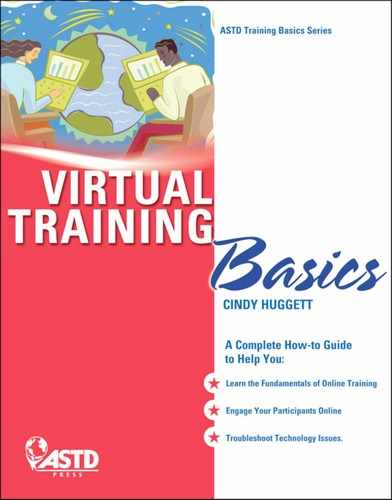Preface
So you've been asked to deliver training in a virtual classroom, and you don't know where to begin. Or you've delivered a few online classes, and are not quite comfortable with the technology. Or maybe you keep hearing that virtual training is the wave of the future and you want to stay current. If any of these scenarios describe you—congratulations! You've come to the right place.
This book will help you get started in the process of delivering successful virtual classes. It is designed for classroom trainers who are migrating to virtual delivery. This book will also help first-time virtual trainers, and anyone who is asked to present or facilitate online.
The Move to Virtual Training
Over the past decade, industry studies have shown a trend toward increased virtual training. The 2009 ASTD State of the Industry Report indicated that instructor-led online learning increased from 4.24 percent of overall formal learning hours delivered in 2006 to 6.42 percent in 2007. While this increase may not seem like much, that's an increase of over 2 percent in one year! And when you consider that the annual total dollar amount spent by U.S. organizations on employee learning and development is estimated at $134.07 billion, we're talking about a significant yearly increase in virtual training delivery.
More recent research by Bersin & Associates in The Corporate Learning Factbook 2009 indicates that average training expenditures decreased in 2008 because of the economic downturn. Bersin also reports a reduction in virtual classroom training, mostly as a result of budget and staffing cuts.
While the full impact of this spending reduction is not yet fully known, another interesting 2009 ASTD research report, Learning in Tough Economic Times, found that nearly seven out of 10 respondents are "looking for ways to become more efficient at delivering learning" and "more than half had restricted travel for learners." The survey respondents indicated interest in "new and less expensive methods of delivering learning, including e-learning, simulations, and other online options."
While virtual instructor-led training is not the only online option available, it still represents a significant portion of training delivered to learners. More and more trainers will be asked to use technology in training implementations. Traditional classroom training is not going away; however, training professionals must diversify their skill set in order to stay relevant in the new economy.
Just because a trainer is effective in a traditional training class does not mean he or she will be effective in the virtual classroom. It is a new delivery environment. Many trainers—especially those who are not technology savvy—need to learn the nuances of the online classroom. Virtual training delivery requires an updated skill set for trainers.
This book will help both new and experienced classroom trainers get started in the virtual classroom.
We’ll look at our definition of virtual training in more depth throughout the chapters; however, this book defines virtual training as a synchronous online event, with participants and a trainer meeting together at the same time, using a software program designed as a virtual classroom.
Why This Book?
When I talked with fellow trainers about virtual training, the question was always the same: "How did you learn?" Which really meant they wanted to know, "How can I learn?" After having this same conversation over and over, it became apparent to me that a basic "how-to" book was needed for those brand-new to virtual training. A resource to answer the questions:
- Where should you start when learning how to deliver in the virtual classroom?
- How do you learn to deliver in the virtual classroom?
- What's different about virtual training as compared to classroom training?
This book seeks to answer those questions. It represents my experience in delivering hundreds of virtual classes over the years. It also contains advice and stories from my training colleagues. We hope you can learn from our consolidated experiences, and hope it leads you toward becoming an effective virtual trainer.
Although this book is primarily written for classroom trainers who are new to virtual training, anyone needing to lead virtual meetings will benefit from the tips found in it. In addition, trainers with limited experience in the online classroom may also discover new tips and techniques that will benefit them.
Format of the Book
This book is divided into 10 chapters. They can be seen as the 10 steps you should follow to become a great virtual trainer. Each chapter outlines a necessary skill or preparation step for effective online delivery.
While I recommend you read and apply all of the steps outlined in this book, if you are short on time, just look at the beginning and ending of each chapter for the basics. It's also OK to jump to the chapter you need, especially if you have done this for a while or just need help with a specific topic. You will find this book is full of checklists and worksheets to get you up to speed quickly.
By the way, because successful virtual training promotes networking and collaboration, I asked several of my friends and colleagues to offer advice, tips, and share stories of their own. I think you'll enjoy learning from their experience in addition to my own.
Organization of the Chapters
This book is presented in chapters that are loosely organized in the order you should follow them. I say "loosely" because many of them occur simultaneously when you are delivering a virtual class. For example, "Harness Your Voice" in chapter 7 and "Engage Your Participants" in chapter 8 both happen during delivery. Some of the steps need to be done prior to the class, such as "Set Up for Success" in chapter 5 and "Practice, Practice, Practice" in chapter 9. As I've already mentioned, it is OK for you to go directly to the chapter where you need help, or to skip around the book in the order that makes sense to you.
Here is a brief overview of the chapters:
Chapter 1: What Is Virtual Training? There are varying definitions of virtual training, and it's important to know the options available to you as a training professional. In this chapter, we'll define what "virtual training" is, and what it isn't.
Chapter 2: Virtual Training Is Still Training. What's similar between face-to-face classroom training and virtual training? It's still about training! Improving productivity and getting better business results are still the goals. Technology is just a tool to get us there. You can rest assured that training skills are still needed in the virtual classroom. In this chapter, we'll review the training skills needed to be a successful virtual facilitator.
Chapter 3: Learn About Technology. To be an effective virtual trainer, you need to be 100 percent comfortable with your computer, both its hardware and software. You'll also need basic technical troubleshooting skills. In this chapter, we'll focus on the technology background you need when training in the online classroom.
Chapter 4: Master Virtual Classroom Software Programs. Just like a craftsman masters the tools of his trade, a virtual trainer must expertly know the software programs used in online delivery. In this chapter, we'll cover the typical capabilities of virtual classroom software and how to use its features in an online class.
Chapter 5: Set Up for Success. What a trainer does prior to class affects the success of the class. A virtual trainer's preparation includes learning the content and learning about the participants, as well as setting up the classroom. In this chapter, we'll go through a recommended preparation process, starting with your initial look at the material through getting ready for a virtual class.
Chapter 6: Get Really Good at Multitasking. Virtual trainers need to talk, type, and click at the same time, juggling the course material, technology, and participants all at once. In this chapter, we'll review 10 tips to be a better multitasker.
Chapter 7: Harness Your Voice. In the virtual classroom, trainers connect with participants using their voice. In this chapter, we'll consider ways to use your voice—and how not to use it—so that it's an asset to your virtual delivery style.
Chapter 8: Engage Your Participants. Trainers must engage participants in any class, and even more so in the virtual classroom. In this chapter, we'll learn how to get participants' attention and keep them involved throughout a virtual class.
Chapter 9: Practice, Practice, Practice. Any time you learn a new skill, practice makes perfect. This is true with virtual training as well. While you may never be "perfect" in the classroom, you will gain confidence and experience when you practice. In this chapter, we'll review tips for getting practice, and ways to get quality feedback to improve your delivery.
Chapter 10: Know What to Do When Everything Goes Wrong. Virtual trainers can and should expect technical challenges. In this chapter, we'll cover what types of things typically go wrong in the online classroom, and what you should do when these problems happen.
Look for These Icons
 |
What's Inside This Chapter Each chapter opens with a summary of the topics addressed in the chapter. You can use this reference to find the areas that interest you most. |
|
 |
Think About This These are helpful tips for how to use the tools and techniques presented in the chapter. |
|
 |
Basic Rules These rules cut to the chase. They represent important concepts and assumptions that form the foundation of virtual training. |
|
 |
Noted This icon calls out additional information. |
|
 |
Getting It Done The final section of each chapter supports your ability to take the content of that chapter and apply it to your situation. Sometimes this section contains a list of questions for you to ponder. Sometimes it is a self-assessment tool. And sometimes it is a list of action steps you can take to enhance your facilitation. |
Acknowledgments
I dedicate this book to my best friend and husband, Bobby Huggett. Without his love and support, this book would never have been written. I also want to honor my grandmother, Martha Leeson, for her encouragement along the way.
I give special thanks to the training professionals who willingly shared their advice and stories about the virtual classroom: Mike Abrams, Lynne Hobbs, Kella Price, Kathy Shurte, Tracy Stallard, Jeff Smith, Rebecca Ward, Jim Wilcox, Joe Willmore, and Sharon Wingron. I am grateful to each one of you for your willingness to offer your wisdom. Your contributions have enriched this book. Thank you.
I also express my gratitude to Wendy Gates Corbett, my Infoline co-author and friend, for sharing her thoughts, suggestions, and insights on the content, as well as her virtual training expertise.
Finally, thank you to Paige Smith for reading an early version of this manuscript, and to Justin Brusino at ASTD Press for his patience, encouragement, and advice.
Cindy Huggett
Psalm 115:1
May 2010
